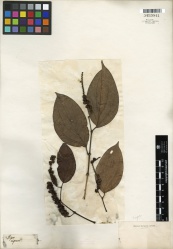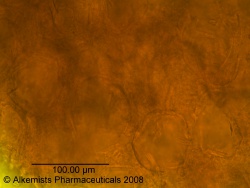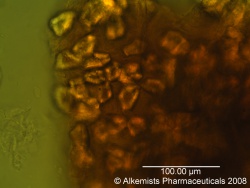|
AHPA recognizes other valuable resources exist regarding the identity of Piper nigrum.
To submit a suggestion or contribution, please contact Merle Zimmermann.
|
Nomenclature
Piper nigrum L. Piperaceae
Standardized common name (English): black pepper (with cortex); green peppercorn (green with cortex); white pepper (decorticated)
Ayurvedic name(s): maricha
Botanical Voucher Specimen
 |
|

Source: MOBOT, Tropicos.org[1]
|
Organoleptic Characteristics
Odor aromatic, slightly empyreumatic; taste aromatic, very pungent.
Source: Culbreth, D. (1917) A Manual of Materia Media and Pharmacology, 6th ed. [2]
|
|
|
|
|
Macroscopic Characteristics
| Plant: Perennial evergreen, dioecious climber; stem 6-9 M. (20-30°) long, articulated, smooth, woody, joints thickened, from which adventitious rootlets arise for adhering to support or taking root in the soil; leaves 10-15 Cm. (4-6') long, ovate, petioles 12 Mm. (1/2') long, acute at base and apex, entire, smooth, leathery, dark green, 5-7-nerved; flowers whitish, unisexual, sessile, elongated spikes.
Fruit: berry-like, sessile, green, then red, and when ripe yellow, nearly globular, 3.5-6 Mm. (1/7 - 1/4') broad, epicarp very thin, easily separable from the sarcocarp, grayish-black, coarsely reticulate, unilocular, 1-seeded; seed nearly white, hollow, adhering to pericarp.
Source: Culbreth, D. (1917) A Manual of Materia Media and Pharmacology, 6th ed. [3]
|
|
|
|
|
Microscopic Characteristics
| Powder grayish black, microscopically -- blackish-brown fragments of pericarp and nearly white of endosperm and embryo, starch grains 0.001-0.003 Mm. (1/25000 - 1/8300') broad, stone cells of epicarp and endocarp with reddish-brown substance, oil cells with yellowish oil from which piperine prisms may separate.
Source: Culbreth, D. (1917) A Manual of Materia Media and Pharmacology, 6th ed. [4]
|
|
|
|
| Cellular structures identified in this botanical specimen are yellow oil gland seen within the outer region of the mesocarp and a group iso-diametric stone cells when observed at 400x with Acidified Chloral Hydrate Glycerol Solution.
Source: Elan M. Sudberg, Alkemist Laboratories [5]
|
|
|
|
|
High Performance Thin Layer Chromatographic Identification

Piper nigrum HPTLC ID - Vanillin Sulfuric Acid Reagent UV 365 nm
Black Pepper (fruit) (Piper nigrum)
Lane Assignments Lanes, from left to right (Track, Volume, Sample):
- 3 μL Piperine ~0.1% in CH3OH
- 3 μL Piper nigrum-1 (fruit)
- 3 μL Piper nigrum-2 (fruit)
- 3 μL Piper nigrum-3 (fruit)
- 3 μL Piper nigrum-3 (fruit)
- 3 μL Piper nigrum-4 (fruit)
- 3 μL Piper nigrum-5 (fruit)
- 3 μL Piperine ~0.1% in CH3OH
Reference materials used here have been authenticated by macroscopic, microscopic &/or TLC studies according to the reference source cited below held at Alkemists Pharmaceuticals, Costa Mesa, CA.
Stationary Phase Silica gel 60, F254, 10 x 10 cm HPTLC plates
Mobile Phase toluene: ethyl acetate [7/3]
Sample Preparation Method 0.3g + 3mL 100% gr EtOH, sonicate/heat @ 50°C ~ 1/2 hr
Detection Method Vanillin/H2SO4 Reagent -> 110° C 5 min -> UV 365 nm
Reference see Pharmacopoeia of The Peoples Republic of China, Volume 1, 2005
Source: Elan M. Sudberg, Alkemist Laboratories [8]
|
Supplementary Information
Sources
- ↑ MOBOT, Tropicos.org http://www.tropicos.org/Image/100213130
- ↑ Culbreth, D. (1917) A Manual of Materia Media and Pharmacology, 6th ed.
- ↑ Culbreth, D. (1917) A Manual of Materia Media and Pharmacology, 6th ed.
- ↑ Culbreth, D. (1917) A Manual of Materia Media and Pharmacology, 6th ed.
- ↑ Elan M. Sudberg, Alkemist Laboratories http://www.alkemist.com
- ↑ Elan M. Sudberg, Alkemist Laboratories http://www.alkemist.com
- ↑ Elan M. Sudberg, Alkemist Laboratories http://www.alkemist.com
- ↑ Elan M. Sudberg, Alkemist Laboratories http://www.alkemist.com





